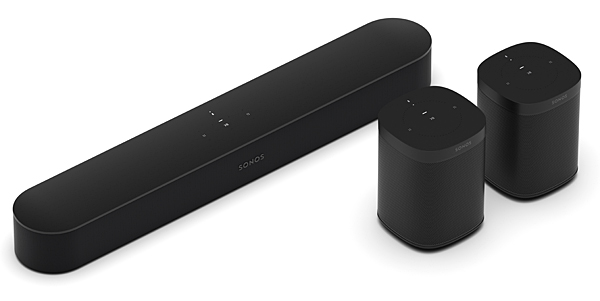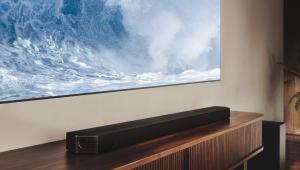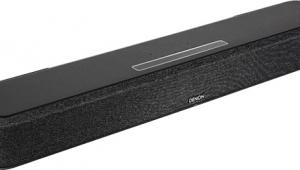Sonos Beam Wireless Soundbar Review Page 2
Finally, note that the Beam and Sonos One will be AirPlay2-compliant with a forthcoming software update. And Google Assistant will eventually be an option for both speakers if you prefer that voice platform to Amazon’s Alexa.
PlayItAll Bar
I placed the Beam on a 26-inch speaker stand in front of my 60-inch TV, which put the bar just below the screen and canted it back 5 degrees for more direct projection at my ears when I sat on the sofa 9 feet away. Setup was a breeze. The Sonos app walks you through making the HDMI ARC connection, and my TV immediately linked with the Beam via HDMI-CEC. More critically, Sonos has greatly simplified the sequence required to activate Alexa with what it calls auto skill-enabling. u All that was needed was logging on to my Amazon account, which I did from within the Sonos app, and everything else happened automatically. I listened to the Beam alone with music and movies, then added a pair of Play:1 surrounds and a SUB subwoofer for the full theater experience.
After a bit of casual music listening , it was apparent that the Beam offers the characteristic Sonos voicing, which is to say largely neutral across the spectrum, with a well-defined midrange and detailed highs—and never, ever, crossing into offensively overblown bass or exaggerated treble. Different Sonos products make different compromises from the ideal, however, and it was clear that the Beam is optimized more for TV sound than music. That’s not to say it wasn’t extraordinary with my playlists and quite excellent for its price point. But in a direct A/B with the music-centric Play:1 (which is voiced identically to the Sonos One), the Beam lacked the Play:1’s midrange focus and its last word in high-frequency definition and sparkle ; the kind of difference that can be heard in the fine detail and metallic shimmer of brushed cymbals and the like. I have little doubt that the multiple horizontal drivers in the Beam's array and the intentional prestidigitation of the signal in the name of creating a wider and taller soundstage from the small bar makes the vocals a touch more amorphous versus the Play:1's point source. But these slightly "broader" and more reverberant mids and gently subdued highs would have been lost on most folks, especially in the absence of direct comparison. And especially not with movie and TV soundtracks, where such characteristics helped prevent any hint of listener fatigue, even after long sessions. Nor could I argue with the impressively spacious sound, with vocals emanating from well above the bar at the middle of my screen and the stage extending just beyond the set's edges. Sonos made reasonable trade-offs for what is admittedly a soundbar first and foremost.
Whatever the finely-honed audiophile ear might notice in the Beam’s mids and highs, it easily made up for in its bass response, which (of course) trounced the tiny Play:1. I ran bass tones through the Beam using the app’s default tone settings (bass and treble flat, loudness contouring on) and found that, in my large basement studio space (20 x 25 feet with short, 6.5-foot ceilings), and without any nearby walls, it produced noticeable bass to 50 Hz before falling off sharply.
CD-quality music tracks from Tidal on the Beam were highly engaging thanks to its overall accuracy and spaciousness, and its pleasantly rich and defined bottom end. “Wild World,” by the Americana band Drew Holcomb & the Neighbors, was one of many standouts. The recording starts with the sound of a distant, wailing siren coming from somewhere outside the studio ; it was so convincing on the Beam that I paused the recording thinking there was really an emergency vehicle flying by on the street. When Holcomb’s close-miked acoustic guitar started in I luxuriated in the leading edge of the plucks and the occasional screech of finger sliding on string. Holcomb’s folksy vocal was delivered with both a dimension and immediacy that betrayed the Beam’s size, assisted by bass extension that gave it just enough fullness and body. I could also easily detect the subtle dynamic build Holcomb delivered for the next-to-last verse, where he picked up the volume to signal the pending final chorus. "Solitude" by Sonny Rollins, from Way Out West, nicely highlighted the Beam's low-end definition on Ray Brown's stand-up bass, and Rollin's meandering sax was delivered with both lifelike size and appropriately reedy smoothness. Adele's "Make You Feel My Love" also offered ample opportunity for the Beam to strut, from her incredibly silky and dynamic voice (huge, and not even remotely edgy on the high notes), the wonderfully full-sounding piano accompaniment, and the sweet violin refrain.

As for home theater, I turned to the opening scene of Dunkirk, which relies heavily on the dynamic swings between rifle fire, dropped bombs, and screaming prop fighters, and more subtle close-miked foley effects (such as paper fluttering, a squeaky window hinge, and a falling carpet of sand on the beach). gt For such a tiny soundbar, the Beam pulled it off with aplomb. It lacked the bass depth required for the full reproduction of the gunfire and bomb effects, but ,thit the mark readily on everything else. Dialogue was clean and intelligible, even during sequences where the fighter pilots' British accents are muffled through their masks; I never once touched the app’s Speech Enhancer mode. Score elements like terse violin swells were projected with an appropriate texture that gave them dimensionality and weight.
As a contrast to Dunkirk, I watched a bit of Song to Song, a no less disturbing love-triangle romance from Terrence Malik that's set in the world of professional musicians and is all about the dialogue (both internal and between characters) and relies heavily on popular music for its soundtrack. Here again, voice reproduction was clear as a bell, and the song breaks took powerful center stage when they kicked in. At one point early on, when some horn players are practicing at a recording session, their trumpet and saxophones came through with convincing timbre and body.
Without question, the Beam was greatly enhanced by the addition of Play:1 surrounds and the SUB subwoofer. I introduced the surrounds first and found that they not only turned the Dunkirk opener into a more immersive scene, with gunfire all about and score elements coming from behind, but they also took some dynamic burden off the tiny bar and allowed the system to play louder and with more authority. Adding the SUB further improved overall output to where I substantially cut back the volume control, and it gave visceral impact to the opening gunplay while reproducing its full echo in the deserted, narrow streets of the town. This was quite the startling transformation, and for my listening area (which is only about 12 feet wide), the full Beam system delivered an experience that rivaled many with three discrete speakers up front. Music tracks similarly came alive when they gained the subtle ambiance from the rear speakers and the addition of substantial deep bass. The cost of these extra speakers is high—$1,000 worth of kit bolted on to a $400 soundbar. But there was no denying their sonic value.
Conclusion
There's a lot to like with the Sonos Beam, not the least of which is what calculates—by my math, anyway—to a ridiculously good value. It makes some canny compromises to hit its price point, and it won't deliver the reference level output that some listeners crave for serious home theater. But I found it unfailingly pleasant on pretty much any content I tried, both music and movies, and was consistently impressed with just how much high-quality sound it put out given its size and price. Throw in the Alexa "smarts" and ease of use, and the value of having access to the proven Sonos infrastructure and library of music services in your home, and it's hard to understand why anyone with a plain 'ol TV in their room wouldn't want one of these to go with it. Get one while you can. I'm predicting a sell-out for Christmas.


























































